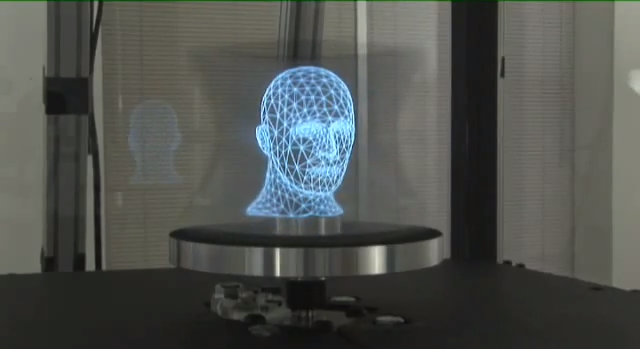
If you ask me what I consider the best part of 3D, then my reply would be 3D holography. What I like most about this new and exotic technology hailing from 3D is it gathers together a number of futuristic and technologically superior trends into a compact form that could be mind-numbing at times.
3D holography hasn’t yet grown up, in fact it is still far from growing up. But my hunch is within ten or fifteen years from now, we are going to see some real improvements. What compels me have this hunch are the recent developments that are awe-inspiring. Different commercial segments importing 3D solutions, 3D making inroads into digital art and scientific concepts are being applied by the technologists.
3D holographic video machine
In the mid of 2014, two artists from Scotland introduced a new technology. The machine has been identified as the first of its kind and it can generate a powerful and highly realistic 3D video. The machine debuted at the Edinburgh Art Festival and it showcases top quality 3D holographic effects.
The first video made by the duo featured the space investigation carried out by NASA Voyager 1. The voyager featured in the video wasn’t real, it was a holographic image of the original voyager. The video also featured a conversation between a holographic baby and a 5-year-old child. The child is real, he is the son of Helson and Jackets, the Scottish artists. The holographic baby is the same child.
The artists were inspired by a piece called ‘Help me Obi’ from the legendary Star Wars. Details about the project are indeed astonishing. The two artists worked on the project for almost seven years and the objects, projected by them can have the length of up to 12-inches. The project has given a boost to 3D holographic image rendering industry.
3D holographic technologies
There are some really trendy technologies that belong to the 3D holographic niche. One of them is the electro-holographic display. This technology uses electro-holography to record 3D objects and reconstruct them. This display is distinct from other 3D displays. For example, when the technology reconstructs 3D images, it captures the parallax.
There’s another technology, which is called touchable hologram. It runs a software that relies on ultrasonic waves, and the user who is touching the projected hologram, feels a pressure on his hand.
Holographic TV is perhaps going to be the biggest of surprises. Researchers at MIT are anticipating holographic TV could enter our drawing room in just ten years down the line. If it turned into a valid anticipation, then today’s 2D TV sets would be obsolete from the market.
The laser plasma technology could give 3D an altogether new shape. Aerial Burton has used plasma laser to have 3D images floated in the air. The technology is in its nascent stage currently but it has plenty of rooms to prosper in the future. Technologies such as plasma laser work in a fascinating way, it accounts for opaqueness. Using this technology, light could be viewed without it having to bounce off a surface.
Entertainment and usability
When identifying a technology that is really helpful, one needs to apprehend the fine-line difference between theatrics and usefulness. Not all technologies or solutions are useful. Some are only showpiece stuff while other 3D tools and solutions are renowned for their application.
3D holographic DJ performances could entertain audiences. It’s already happening in various corners of the world. A project in Russia applied this technology in its copyright DVJ set. The project is called Well Done. Similar to entertainment, serious business operations may also make use of 3D holograms. For example, a company executive could conduct a brainstorming session simply by staying at his home and everyone could see his holographic image at office.
Since dynamic, 3D developments are taking place as you read this article. The best thing about the upcoming 3D tools is they combine both theatrics and usability. Those tools offer a unique solution, which can be applied to render high-quality digital art as well as practical solutions. 3D holography qualifies as such a solution. It could revolutionize certain industries like space research, medical research, real estate, architecture, non-photorealism and even entertainment.